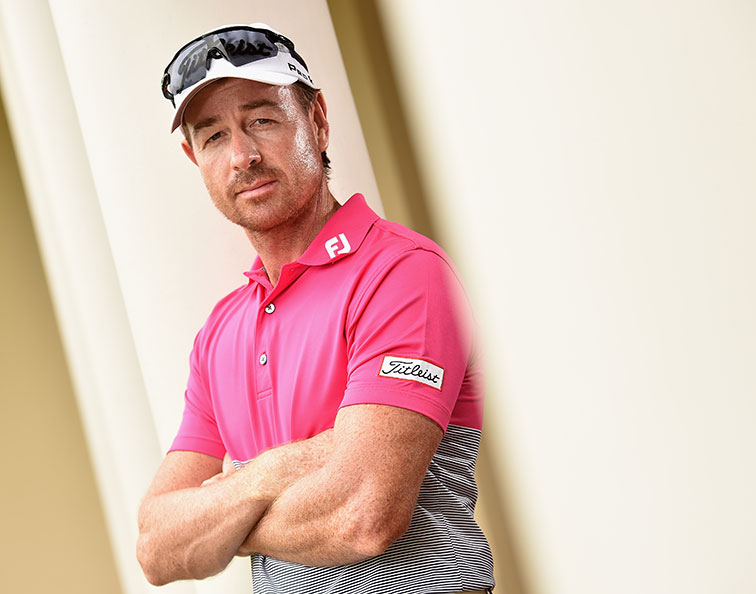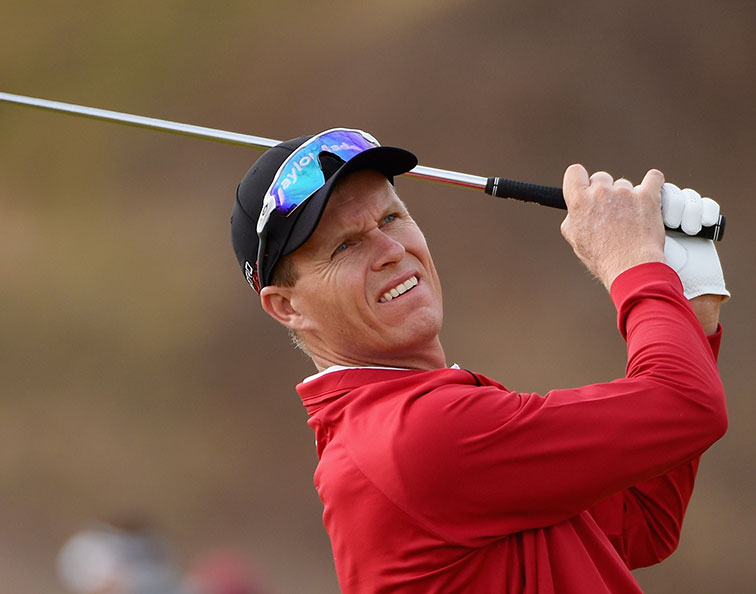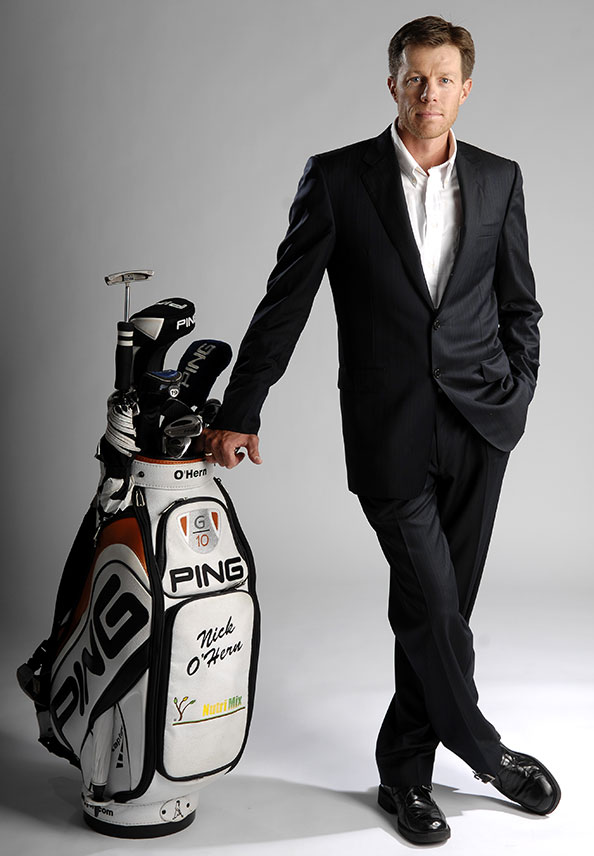It seems Australian golf doesn’t go a month without a young gun announcing his or herself within the sport’s broader consciousness.
On the world stage, Cameron Smith’s spectacular 72nd hole at the US Open at Chambers Bay last year signalled what was to come from ‘generation next’. Domestically, Victorian Rory Bourke led the Queensland Open through 36 holes and it opened the floodgates for more talent to rise.
Amateur Ben Eccles went wire-to-wire at the NSW Open, pre-qualifier Andrew Evans had a putt to push Peter Senior to a playoff at the Aussie Masters, Lincoln Tighe and Todd Sinnott stunned the sport with their prodigious length in finishing inside the top 10 at the Australian Open. Despite a bogey-bogey finish, Nathan Holman held on to win the Australian PGA Championship with Smith, Dimitrios Papadatos and Jordan Zunic registering top-10 places.
It’s an annual occurrence – think Daniel Popovic and Jack Wilson in recent times – and then there’s Ryan Ruffels, Oliver Goss and Antonio Murdaca already getting a sample of life on the US PGA Tour.
“I played with Cameron Smith [at the Australian Open] who seems to be a really good young player,” Nick O’Hern tells Australian Golf Digest.
“He held himself together really well, especially coming towards the end where he was borderline on making the cut. You can always tell how guys react to that sort of stuff as to what type of player they are.
“And he was a nice young guy. Very polite and didn’t lose his temper. He had a good guy on the bag. You know when they’ve got good caddies they must be pretty good blokes because good caddies don’t like to work for a—holes.”

A five-time winner in Europe, Brett Rumford is a qualified judge on how our rising stars will stand up to the pressure of big tournaments.
“They’re all great players these days and the style of the golf is changing so dramatically that I can’t really relate to a lot of their games,” Rumford concedes.
“When you hear about Todd Sinnott hitting a wedge into the par-5 fifth [at The Australian, 553 metres], that’s just obscene. I just can’t fathom that kind of length.
“Ben Eccles won the NSW Open … great little player. Met him and he just seems to be a rounded, down-to-earth guy, and they’re not always like that.”
So, what’s next?
Holman’s win at Royal Pines catapulted him straight onto the lucrative European Tour and a start at the WGC-Cadillac Championship. But for the others chasing big dreams, a first step to career longevity remains elusive.
For many, first forays into life on tour will come through Asia, a path well travelled by Aussies in recent years. It’s where John Senden began his journey, citing the $42,000 he received for winning the Indonesian Open in Jakarta as the kick-start for what was to come in Europe – and eventually the USPGA Tour.

“I had nothing and I ended up winning $42,000 and at that time I thought it felt like a million bucks,” says Senden.
“That gives you confidence and a stepping stone to keep playing in Asia where I was playing in the ’90s.
“I always had the goal to play the US PGA Tour but I wanted to look at who was playing the best golf at the time and those guys were (Greg) Norman, (Ian) Baker-Finch, (Wayne) Grady, (Peter) Senior and they all went to Europe before they went to America. That was the stepping stone for us.
“I always felt that without my experience playing in Asia and Europe beforehand, I would never have survived on the US PGA Tour.
“You need hard work, a bit of luck, experience and then you can hopefully make it.”
The Big Break
There’s an old saying: ‘luck is where preparation meets opportunity’. Senden, Rumford, O’Hern – even Nathan Green – all have a story to tell about the day their lives changed for the better. All thanks to one slice of good fortune.
Many considered Green’s $500,000 hole-in-one at the 2001 Australian Masters as the catapult to his nine-year career on the US PGA Tour. But he said it was actually his opening two weeks as a full member in the US – he finished fifth at the Sony Open and lost the Buick Invitational in a playoff with Tiger Woods and Jose Maria Olazabal.
“If I had won my second week on tour as a professional it probably wouldn’t have been a good thing for me,” Green says of his early financial windfall.
“My big break was those first two or three weeks on the US PGA Tour where I really had to play well to re-rank, and I did. I played great, but as soon as I won in 2009 (RBC Canadian Open) I saw it as the pinnacle. I never saw it as a stepping stone for more success and maybe that’s what would have happened had I won my second event on tour.
“I was playing with some big-name guys and when you perform playing with those sorts of golfers … I had Retief (Goosen), Vijay (Singh), (Phil) Mickelson in the second week, Olazabal, a host of guys who I was a bit intimidated by in those first few weeks and I played really well.
“For me, that was the moment when I thought, Maybe I’m a decent player after all.”
!["[Golf Australia] gives 10 guys $100,000 to start them off. I reckon it'd be better to give 20 guys $50,000 each and keep them hungry for success." Nathan Green](http://australiangolfdigest.com.au/wp-content/uploads/2016/08/Survive_04.jpg)
Western Australian Rumford’s big break came in 1999, when an invitation for amateur Aaron Baddeley to play in the PGA Tour of Australasia’s ANZ Players Championship opened the door for the entire Australian Golf Union national squad to participate. Rumford went out and beat all the leading professionals in the country.
“Baddeley winning the Australian Open the week before was my sliding doors moment,” Rumford recalls.
“Luckily, enough of the four-man Aussie team got a berth in that TPC Championship and I went on to beat Craig Spence in a playoff.
“Call it what you want, but that gave me the five-year exemption because it was the TPC Championship – their flagship event.”

The Transition Phase
Very few Australian male golfers have made a seamless transition from the amateur to professional ranks in recent years.
Those currently at the top of the golf totem such as Adam Scott and Marc Leishman did their early years in Europe and Korea, respectively. Nick Flanagan, Michael Sim, Won Joon Lee and Andrew Buckle burst onto the professional scene but were unable to find sustained periods of success.
According to Rumford, there are no guarantees the next wave will be any more successful.
“To take it to the next level, if you’re talking about wanting to fill the shoes of someone like Scotty, Sergio Garcia, Rory McIlroy, the big-name players, the household names with massive games that are winning regularly and contending for Majors, they play a particular game and possess a mentality that comes along very rarely,” he says.
“Just because you’re a good amateur doesn’t mean you’re going to take the world on. That’s what these young kids have to understand. It’s a different world; if it doesn’t happen instantly, it may not happen.
“Getting your foot in the door and retaining that card year in, year out, that’s a skill in its own right and it’s a mentality.
“It’s a constant weight that will live with you for your whole career. Having to perform and to get up, to keep driving yourself to better yourself and to grow as well. It certainly is a tough gig, I think.”
The implementation of Golf Australia’s Rookie Squad is designed to make the transition for elite amateurs into the professional ranks easier by way of funding. But Green – who has returned to Australia to set up a coaching base at Toronto, south of Newcastle – is concerned others may be slipping through the net.
“I know they give 10 guys $100,000 to start them off; I don’t know whether that’s a good thing or a bad thing. I reckon you’re better off giving 20 guys $50,000 each and keeping them a bit hungry while still helping them out,” says Green.
“I’ve had a little bit to do with Lincoln [Tighe] and he’s someone that is doing it on his own and doing well. He would really benefit from it.
“Lincoln has got what could be an awesome game for playing in the US. It’s that sort of player that’s going to get through the
Web.com now.
“It’s getting harder and harder for a shorter hitter to play that tour and get through. There are some guys that may not have been the world’s best amateurs but they come into the pro ranks and do it a little bit under the radar and start to perform well.”
By giving a broader base a leg-up into the professional ranks, Green believes there is a greater opportunity for those with the mental strength to deal with pro golf’s hardships to show what they are made of.
“I’ll always judge a player after they go through a period where, for example, they miss six cuts in a row and they’re sitting in a hotel room in Colombia wondering what they’re going to do with their life,” Green says bluntly.
“Most guys go through hardship early on; some guys bounce back from it and it makes them better players. Others don’t and they really struggle.
“You don’t know and that’s why I like the idea of casting a bigger net and getting some more guys into that sort of program.
“The blueprint we’re working to where guys all go through the same fitness regime, the same coaching, the same reporting back in … having your coach with you at tournaments for a certain amount of weeks doesn’t work for everybody.”




